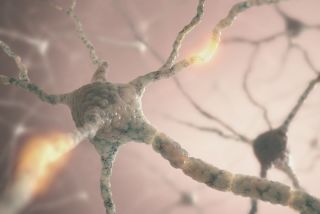The Science of How Spravato Works: NMDA Receptor Modulation

Depression is one of the most common mental health conditions, yet many people struggle to find relief with traditional antidepressants like SSRIs and SNRIs. For individuals with treatment-resistant depression (TRD), new therapies are crucial. One such breakthrough is Spravato (esketamine), a nasal spray that works by modulating NMDA receptors in the brain—a mechanism unlike anything in standard antidepressant treatments.
This blog explores the science behind Spravato, delving into how it interacts with the glutamate system, promotes neuroplasticity, and provides rapid relief from depression.
What Are NMDA Receptors?
The N-methyl-D-aspartate (NMDA) receptor is a protein found on neurons throughout the brain. It plays a key role in regulating:
- Glutamate levels—the most abundant excitatory neurotransmitter in the brain
- Learning and memory by controlling synaptic plasticity
- Mood regulation through its influence on neural networks
In individuals with depression, NMDA receptor activity and the glutamate system can become dysregulated, leading to rigid thought patterns and emotional responses. This disruption contributes to low mood, fatigue, and cognitive decline, hallmark symptoms of major depressive disorder.
How Does Spravato Target NMDA Receptors?
Unlike SSRIs that target serotonin reuptake, Spravato works by blocking NMDA receptors. Here’s a step-by-step look at how this process unfolds:
- Blocking NMDA Receptors: Spravato binds to the NMDA receptor, inhibiting its function. This inhibition prevents excess glutamate activity, which plays a role in depressive symptoms.
- Promoting Glutamate Surge: Paradoxically, blocking NMDA receptors leads to an increase in extracellular glutamate, stimulating other receptors such as AMPA receptors. These receptors promote neural communication and plasticity, essential for mood regulation.
- Neuroplasticity and Synaptogenesis: The increase in glutamate activates pathways involved in synaptogenesis, the formation of new synaptic connections between neurons. This is key to overcoming depression, as it allows the brain to rewire itself, breaking out of rigid patterns and forming healthier emotional responses.
This modulation of NMDA and AMPA receptors is why Spravato can offer relief within hours to days—a stark contrast to SSRIs, which often take weeks or months to show results.
Neuroplasticity: How Spravato Helps the Brain Adapt
Neuroplasticity is the brain’s ability to adapt and reorganize itself by forming new neural connections. In people with depression, neuroplasticity is often impaired, leading to repetitive, negative thinking and emotional numbness.
- Rapid Synaptic Growth: By stimulating glutamate pathways, Spravato encourages the growth of new synapses in regions of the brain involved in mood regulation, such as the prefrontal cortex.
- Emotional Flexibility: The brain becomes more adaptable and open to new emotional experiences. This flexibility makes it easier for patients to break free from depressive thought loops and engage with life more meaningfully.
For many, the transformative power of these shifts reaches its potential when combined with integrated therapies like Ketamine-Assisted Psychotherapy (KAP). KAP sessions at Therapeutic Infusions take advantage of ketamine’s and Spravato's ability to enhance neuroplasticity, guiding patients through deep emotional work that helps them reframe thoughts and behaviors.
How Spravato Differs from SSRIs on a Neurological Level
- Faster Symptom Relief: SSRIs typically take 6-8 weeks to build up in the system, while Spravato can provide relief within hours to days.
- Different Target Pathways: Spravato works through NMDA and glutamate pathways, directly impacting neural connectivity, while SSRIs act indirectly by increasing serotonin levels.
- Enhanced Neuroplasticity: Spravato promotes structural changes in the brain, helping it form new connections more rapidly than SSRIs. This is particularly helpful for patients stuck in rigid thought patterns associated with depression.
These differences make Spravato a game-changer for patients who haven’t responded to traditional antidepressants.
The Role of AMPA Receptors: An Indirect Boost
One important secondary effect of NMDA receptor modulation is the activation of AMPA receptors. These receptors:
- Enhance synaptic signaling, helping neurons communicate more efficiently
- Facilitate long-term potentiation (LTP), which strengthens synaptic connections
- Play a key role in learning and emotional memory formation
The activation of AMPA receptors is believed to amplify Spravato’s antidepressant effects, ensuring that the new neural connections formed during treatment are strong and long-lasting.
Why the Glutamate System Matters for Depression Treatment
The glutamate system plays a central role in brain function, but its involvement in depression has only recently come to light. Research shows that in people with depression:
- Glutamate transmission is impaired, reducing the brain’s ability to respond to positive experiences.
- Overactive NMDA receptors contribute to feelings of exhaustion and mental fog.
- Restoring balance in the glutamate system can improve mood, cognitive function, and emotional regulation.
NMDA Receptor Modulation: A Revolutionary Mechanism for Mental Health Care
Disclaimer: The information provided in this blog is for educational and informational purposes only and is not intended as medical advice. It should not replace consultation with a qualified healthcare professional. Always seek the guidance of your physician or other licensed healthcare provider with any questions you may have regarding your medical condition or treatment options.





